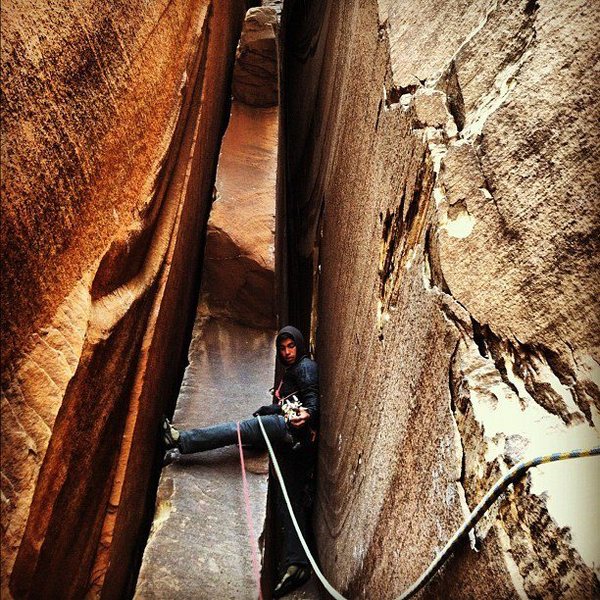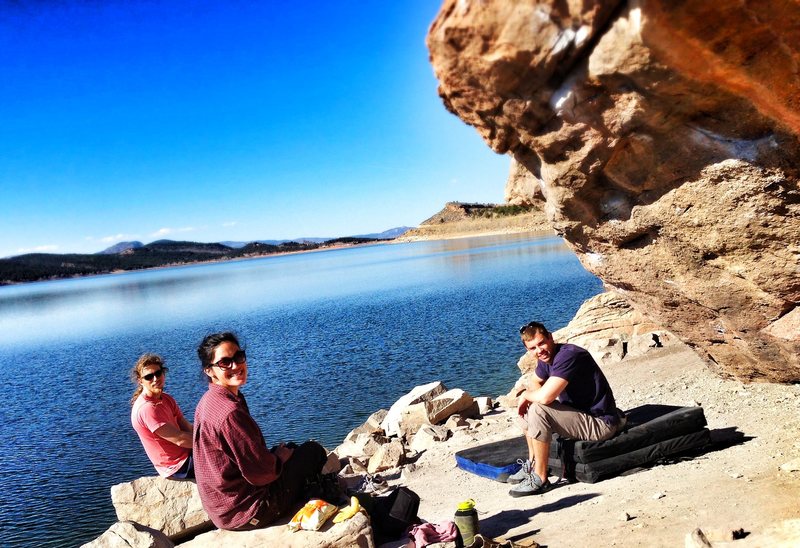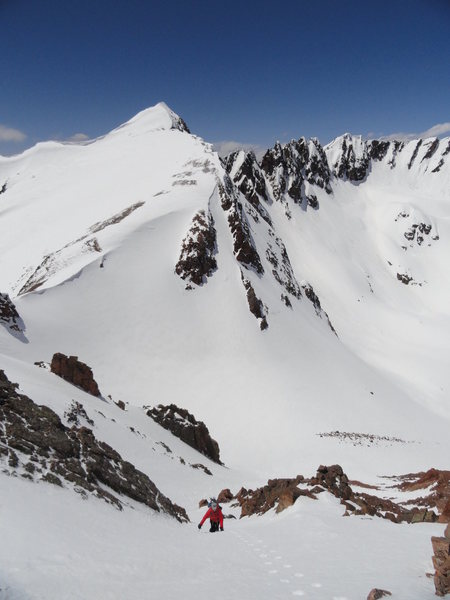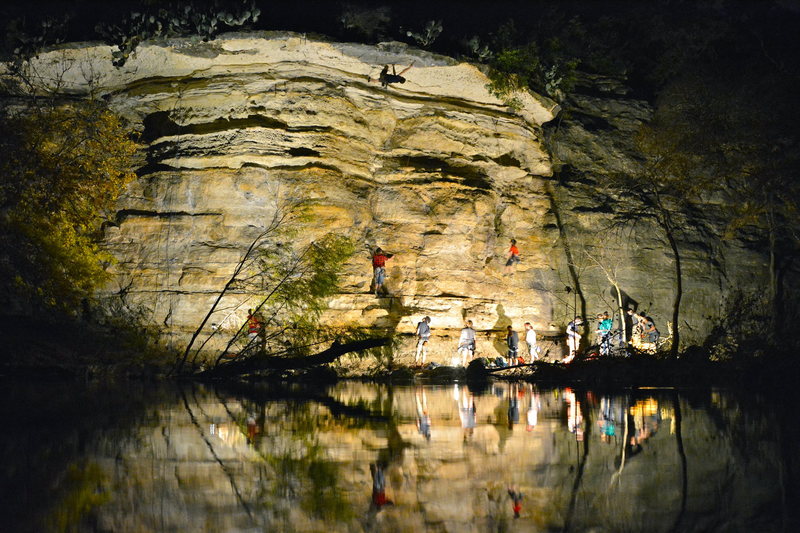Your BEST Climbing Photographs
|
|
|
|
|
|
|
|
|
|
|
Dylan, |
|
|
I don't shoot much climbing, but I do shoot professionally. Here is a story I shot at the Ouray Ice Fest last year: |
|
|
Davis Stevenson wrote:My other reccomendation is to abandon digital. Color rendition, white balance, and overall image quality on a quality film like Velvia is far superior to anything digital except MF digital. If you don't believe me, look at Ken Rockwell's page (also a great source for info about lenses). He shoots everything with Velvia 50 anymore. Scan them if you want, or have them enlarged. A quality 35mm print will enlarge just as well as anything digital. Shooting film will make you much more careful about compisition and make you think anyway.You lost me at Ken Rockwell. Many modern DSRL's exceed the capabilities of 35 mm film. Some can equal or have surpassed medium format in some regards. One does, however, need to learn basic post processing to realize these capabilities. But anyone who is serious about photography will learn how to use Photoshop or the equivalent. White balance and 'color rendition' is no less an issue with digital than it is with film. In fact, it's much less an issue as long as you shoot RAW. I agree that shooting film forces the new photographer to think about composition, exposure, etc. but there is equal, if not more value in being able to shoot hundreds or thousands of images (and review them the same day) with no weight or cost penalty. The brightness histogram is an excellent learning tool, as well. No need to scan. It goes on and on. As digital technology continues to improve, the arguments to 'learn on film' sound a bit like the crusty old veteran who believes the best way to learn to lead trad is to use only nuts and hexes. There is a nostalgic simplicity here that appeals to many of us, but most would probably agree that there are more efficient (and safer) ways to do it. I should add that I totally agree with everything else in your post, though. |
|
|
What ever happened to "f8, and be there" ? |
|
|
Jason Kim wrote: I agree that shooting film forces the new photographer to think about composition, exposure, etc. but there is equal, if not more value in being able to shoot hundreds or thousands of images (and review them the same day) with no weight or cost penalty.An old mentor of mine said once, regarding this about digital, is that 'a quality photo on digital happens by accident, where a quality photo on film happens on purpose'. Not really true, as after shooting film again for the last 4 years I would stop and think more than I used to. If I ever shot professionally, I would most likely go to digital, as that is the expectation. However, until I start selling prints, I'll stick to making fantastic pictures on film, as I could replace the camera I take canyoneering (Nikkormat with a busted light meter, and a dusty 35mm-105mm zoom) for $75, and it can take a lot more abuse than a $1000+ DSLR body with comparable glass. Anyways, with modern film and modern staining developers, I have yet to see a B&W digital photo that I liked better... Does anyone else here still process and enlarge themselves? |
|
|
I don't think there is necessarily an expectation to shoot digital, but there is an expectation for fast turn-around and a digital file, which makes film a poor choice for most professional applications, in this digital age. There are successful landscape photographers who continue to use medium and large format film, but the reasons are less about image quality and have more to do with marketing. |
|
|
Jason Kim wrote:Once you factor in the cost of film and processing, I'm not so sure that using an old 35 mm body will save any money in the long run.Once you drop a modern camera or lens and need to replace it, that's about 2,500 images worth of film and processing (if you do it yourself). I had a high end Fuji P&S I used to use for backpacking and canyoneering (took great pics). I had it double-bagged in dry bags and somehow it got wet and destroyed (now I have a small Pelican case for carrying camera gear whenever there's a lot of water around.). $250+ to replace it. If water got into my Nikkormat, I know I could take the lens apart (on my fixed lenses, haven't tried a zoom yet) and clean it and get it going again, and could scrounge around on Ebay or KEH for a perfectly functioning body for $60-$80. Try that with a DSLR. That's the main reason I got back into film... but I fell back in love with it. Anyways, if necessary, I could definitely take high quality pictures even with this setup: photojojo.com/store/awesome… They're actually pretty sweet, I use that macro lens and the inversion setting on my iPhone to inspect negs. My brother's Droid Razr HD even has exposure compensation and white balance settings on-board. I'm sure you could take magazine quality pictures with that rig, actually... Anyways, sorry to go all luddite. Photography is an art. Use whatever tools are easy to use and give you what you envision. |
|
|
These are NOT my best photos, but I though it would be interesting to show the crazy capabilities of the iPhone and free editing apps, and what you can do on the fly with a minimalist attitude. These are not R&I magazine-quality but their effectiveness in inspiring friends rely on timing, as I will usually post these photos immediately after a session. |
|
|
Davis Stevenson wrote: Once you drop a modern camera or lens and need to replace it, that's about 2,500 images worth of film and processing (if you do it yourself). To be fair, the price of the glass would be the same in either case. I suppose we need to compare bodies and then batteries/memory vs. film/processing. I call it a wash! Davis Stevenson wrote: Photography is an art. Use whatever tools are easy to use and give you what you envision.You hit the nail on the head!! |
|
|
How about some more point and shoot action? Here are a couple of my favorites. |
|
|
|
|
|
|
|
|
Shaking out the pump on Carlsberg Column.
Doug leading the last pitch of Louise Falls Doug leading the last pitch of Louise Falls D70 + Nikkor 12-24mm f4 + RAW My preference is for a super wide lens. You won't really push the limits of most sensors if you don't have good glass in front. |
|
|
Jason Kim wrote: To be fair, the price of the glass would be the same in either case. I suppose we need to compare bodies and then batteries/memory vs. film/processing. I call it a wash! You hit the nail on the head!!Not entirely sure about that, I just picked up a 50mm 1.4 (pre-AI... OLD/transitional bodies only without modification) for $80 and modified it myself. Same optics as the new stuff, for a few hundred less. That's a tip for everyone, though, any of the higher-end prosumer bodies or pro bodies, it will meter and give aperture-priority with any Nikon glass. Check out KEH and eBay, as it takes about 10 minutes and a file to get any Nikon lens from before 1977 to fit a modern body with some auto functionality, and no modification for 85% of the lenses newer than that. It's a great way to get nice glass while you're just getting into it. With careful shopping my whole kit is up to only $350 (28mm, 50mm f/2, 50mm f/1.4, 100mm f/2.8, 135mm f/2.8, old 35mm-105 zoom). I usually cary the 28, 50, and 135, or the zoom and cheap 50 if I might break stuff. I'm processing the last 2 years of stuff I have had this week... Maybe I'll make some scans to proof to show off here (even though I usually hate to). Don't know if I have too many climbing pictures mixed in there, but I do know I have a couple rolls of canyoneering stuff. EDIT: Can't wait to get all my old negs out of storage, too. Probably a few hundred I haven't seen in years. I know I definitely have plenty of good stuff in there. |
|
|
Jason Kim wrote:Questions that really, only you can answer, Dylan. No one knows the conditions you will be shooting in, how you will treat your gear, etc. Since it sounds like you have some fairly legit climbing goals in mind, I'd say that spending the extra money on a lightweight body, weather sealing, etc. will all come in handy, and might be justified if you've got a hookup with Nikon. In my experience, having spent many days in the backcountry in adverse conditions, there are only two things that will keep your camera gear in good operating condition: be as careful as you can and hope for some luck. Water, dust, etc. will eventually find their way into your gear, sealed or not. If it were me, and I was planning to invest in a new rig with the primary goal of making publish-worthy images during climbing trips, I'd buy a used version of a newer compact DSLR and a used zoom that covers something in the range of 22-100 mm (adjust for cropped sensor). Since the likelihood of damaging your gear beyond repair is very real, I wouldn't bother spending the money on new equipment, or an expensive body. Hopefully it will last you a season or two, and it won't be too painful to replace it after you smash your camera against a rock. Kinesis ( kgear.com/store/) makes some nice accessories, including harness/strap systems that you might find useful. I use some of their stuff on extended backpacking trips when I'm carrying a ton of gear. I appreciate your desire to raise the stoke, and I will happily play along! Here's a shot of the moon and Jupiter over Mt. Hitchcock, as viewed from the west face of Mt. Whitney. Unfortunately, I don't really have any shots that involve bona fide climbing since it seems I'm always doing one or the other (it's damn hard to make nice photos while climbing). I do have some photos that climbers might appreciate, though. Canon 5D2, Canon 24-105L. Shot at very high ISO while bracing the tripod against my body to combat some fierce wind. Canon 5D2, Canon 17-40L. Sunrise from the summit of Haleakala, a standard tourist shot. Canon 5D2, Canon 17-40L. Lying in my tent at sunrise, and everything started to turn pink. I stuck my head outside the fly and saw this scene directly above. I have never moved so fast to get a shot set up. The light was gone less than a minute later.Pretty good. I also love the great outdoors. I like photography. But my parents wouldn't let me go to the adventure. |
|
|
Hi all, thought I'd bring this thread full circle with some shots through the new glass! |
|
|
Dylan, |

 Continue with onX Maps
Continue with onX Maps Continue with Facebook
Continue with Facebook


























































